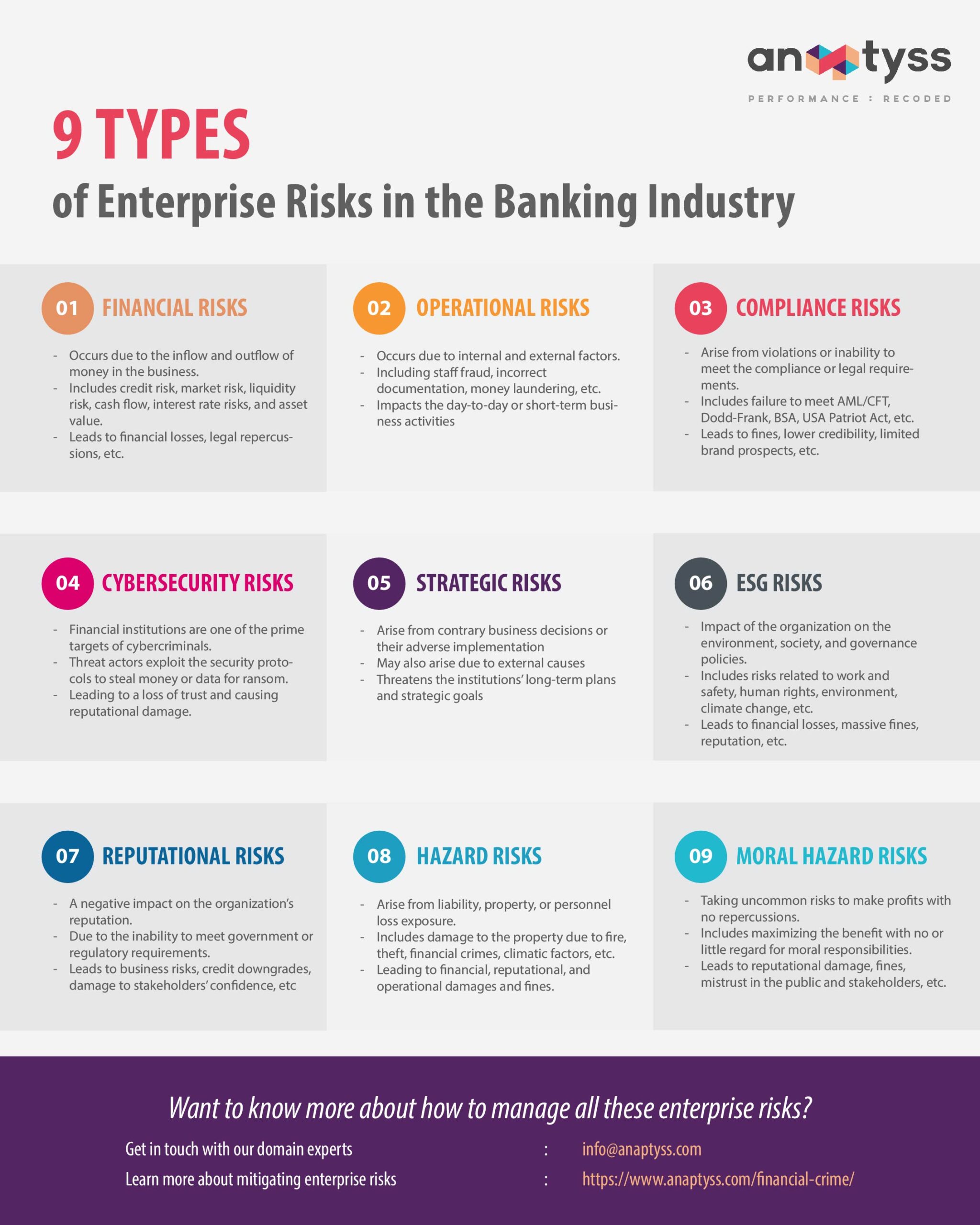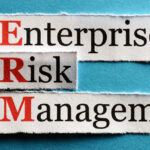In this blog, we dive into the comprehensive realm of Enterprise Risk Management (ERM), exploring various types of risks that financial institutions face, from financial and operational risks to ESG and reputational risks. Discover how Anaptyss employs a preemptive and domain-centric approach to help banks effectively manage these risks, ensuring compliance and safeguarding their business.
Enterprise risk management is more than just a regulatory checkbox; it’s the bedrock of a resilient financial institution. It refers to the process and systems in place to identify, manage, and reduce the adverse outcomes of risks.
Enterprise risks are a constant undercurrent that exists throughout the business cycle. In an era of economic volatility, digital transformation, and increasing regulatory scrutiny, a proactive approach to risk is non-negotiable. This guide will not only define the nine critical types of enterprise risks but also explore the practical implications and mitigation strategies for each.
1. Financial Risks
Banks and financial institutions experience financial risks that occur due to the inflow and outflow of money, or the effect of market forces on financial assets, which can lead to sudden losses.
Financial risks include a spectrum of threats that directly impact the balance sheet:
- Credit Risk: This is one of the most significant risks for banks, occurring when a borrower fails to meet payment obligations on a loan or mortgage.
- Market Risk: This arises from movements in market prices, such as interest rates, foreign exchange rates, and equity prices.
- Liquidity Risk: The risk that a bank cannot meet its short-term financial demands without incurring unacceptable losses.
Mitigation Strategies:
While banks are not protected from financial risks, they can lower their exposure by implementing a robust risk assessment framework. Key tactics include:
- Performing rigorous credit analysis on borrowers before loan origination.
- Securing loans with adequate collateral to recover potential losses in case of default.
- Diversifying the loan portfolio across different industries and geographic regions to avoid concentration risk.
- Using financial derivatives to hedge against interest rate and currency fluctuations.
2. Operational Risks
Operational risks result from failed or inadequate internal processes, people, systems, or external events. These risks can impact day-to-day business activities and may occur due to both internal and external factors.
Examples of Operational Risks:
- Non-compliance with internal banking rules, laws, and external regulatory requirements.
- Internal and external fraud.
- Inadequate documentation or incorrect documentation procedures.
- Infrastructure or technological failure.
- Product or service launch without adequate operational support.
- Adverse legal judgments or government policies.
- Failures in outsourced or third-party activities.
- Physical threats like fire, theft, or natural disasters.
- Financial crimes, such as Money laundering, terrorist financing, etc.
Mitigation Strategies:
- Implementing strong internal controls and segregation of duties to prevent fraud.
- Investing in robust technology and infrastructure with built-in redundancies and disaster recovery plans.
- Conducting regular employee training on processes, policies, and ethical conduct.
- Establishing a comprehensive third-party risk management program to vet and monitor vendors.
3. Compliance Risks
These risks refer to violations of laws or legal requirements due to a financial institution’s inability to meet rules, regulations, procedures, and industry standards, such as anti-money laundering (AML), countering financing for terrorism (CFT), Dodd-Frank, BSA, USA Patriot Act, OFAC sanctions, etc.
The risk can expose a financial institution to severe consequences, including:
- Hefty fines and penalties from regulators.
- Litigation and damage payments.
- A weakened brand and loss of credibility and franchise value.
- Restrictions on business opportunities and expansion possibilities.
Mitigation Strategies:
- Establishing a dedicated and empowered compliance function within the organization.
- Utilizing regulatory technology (RegTech) to automate monitoring and reporting.
- Conducting regular internal audits and risk assessments against current regulations.
- Fostering a strong culture of compliance from the board level down.
4. Cybersecurity Risks
Financial institutions are prime targets for state-sponsored and financially motivated threat actors who exploit digital banking to steal customer data and money.
Key Cybersecurity Threats:
- Ransomware: Where attackers encrypt critical data and demand a ransom for its release. It is estimated that 90% of financial institutions were targeted by ransomware attacks in 2022.
- Phishing Attacks: Deceptive attempts to steal sensitive information like login credentials and account numbers.
- Trojans & Malware: Malicious software designed to compromise systems and steal data.
- Spoofing: Disguising a communication from an unknown source as a known, trusted source.
In addition, cybersecurity risks can also lead to reputational damage if a security incident takes place.
Mitigation Strategies:
- Implementing a multi-layered security architecture, including firewalls, intrusion detection systems, and endpoint protection.
- Enforcing multi-factor authentication (MFA) for all customer and employee access points.
- Conducting regular vulnerability assessments and penetration testing.
- Running continuous security awareness training for all employees to help them recognize and report threats.
5. Strategic Risks
Strategic risks arise from flawed business decisions or their adverse implementation. These risks may also arise due to external causes that lead to a change in business direction. These risks threaten an institution’s long-term plans and strategic goals.
Below are some examples of strategic risk that can derail an organization from achieving its goals:
- A significant change in senior management or leadership without a clear succession plan.
- Unsuccessful mergers or acquisitions that fail to deliver expected synergies.
- Breakdowns in relationships with key stakeholders.
- Failure to adapt to a changing competitive environment.
- Fundamental industry changes, such as a shift in customer expectations towards digital-first banking.
- The unsuccessful launch of a new product or service.
Mitigation Strategies:
- Conducting thorough market research and due diligence before making major strategic moves.
- Engaging in scenario planning and stress testing to understand potential outcomes of decisions.
- Establishing an agile governance structure that can pivot quickly in response to market changes.
- Maintaining clear and open communication with all stakeholders.
6. Environmental, Social, and Governance (ESG) Risks
Environmental, social, and governance (ESG) risks include risks related to climate change, working conditions, anti-bribery practices, human rights, environmental management, and compliance with pertaining laws.
- Environmental risks refer to the impact of the organization on the environment, such as greenhouse emissions, carbon footprint, and the physical risks of climate change on assets.
- Social risks include workplace conditions, including safety, wage equality, human rights violations, data privacy, and community relations.
- Governance risks include business operations and governing policies, such as board oversight, transparency, diversity, corruption and fraud prevention, integrity, and business ethics.
These risks can affect a bank’s reputation, financial position, and operational performance. Every organization remains vulnerable to ESG risks that can lead to:
- Financial losses from ESG investors divesting their holdings.
- Difficulty attracting and retaining socially-conscious customers and employees.
- Massive fines for violating environmental and social laws.
Mitigation Strategies:
- Integrating ESG factors into the core risk management framework and lending decisions.
- Developing and publishing a clear sustainability strategy with measurable targets.
- Ensuring transparent reporting on ESG performance to stakeholders.
7. Reputational Risks
Reputational risk refers to a negative impact on the organization’s reputation from the perspective of customers, investors, and regulators. A bank’s inability to meet regulatory requirements, ineffective service, a major data breach, unethical employee behavior, or mismanagement of records can damage the financial institution’s reputation and stakeholder confidence, potentially leading to customer attrition and a credit downgrade.
Similarly, a bank’s failure to evaluate borrowers and issuing large unsecured loans leading to fraud can also cause mistrust in the bank’s controls and checks.
Mitigation Strategies:
- Promoting a strong ethical culture that prioritizes customer interests.
- Implementing robust customer service and complaint resolution processes.
- Developing a proactive crisis communication plan to manage negative events transparently.
- Actively monitoring social media and news outlets to gauge public sentiment.
8. Hazard Risks
Hazard risks arise from liability, property, or personnel loss exposure. These risks are generally associated with the health and safety of customers and employees and the security of physical assets. Hazard risks include damage to property from fire, theft, natural disasters, etc.
Mitigation Strategies:
- Maintaining comprehensive insurance coverage for property, liability, and personnel.
- Implementing stringent physical security measures at all branches and data centers.
- Establishing and regularly testing business continuity and disaster recovery plans.
9. Moral Hazard Risk
Moral hazard is a situation where one party is incentivized to take unusual risks because they do not bear the full consequences of that risk. In banking, this means taking excessively risky decisions to make short-term profits. These risks arise from inadequate repercussions for risky or bad corporate behavior.
Mitigation Strategies:
- Structuring executive compensation to reward long-term, sustainable performance rather than short-term gains.
- Enforcing strong corporate governance with independent board oversight.
- Implementing “clawback” provisions that allow the bank to reclaim bonuses paid out based on performance that later proves to be unsustainable or based on misconduct.

The Interconnected Nature of Banking Risks
It’s crucial to understand that these nine risks do not exist in a vacuum. They are often interconnected, where a failure in one area can trigger a cascade of events across others. For example:
- A cybersecurity breach (Cybersecurity Risk) can lead to system downtime (Operational Risk), resulting in financial losses and severe damage to the bank’s public image (Reputational Risk).
- An aggressive strategic decision to enter a new, volatile market (Strategic Risk) could lead to a portfolio of high-risk loans (Financial Risk) and potential regulatory violations if not managed correctly (Compliance Risk).
Recognizing these connections is the hallmark of a truly mature Enterprise Risk Management framework.
Frequently Asked Questions (FAQ)
1. What is the most significant risk for banks today?
While credit risk has traditionally been the primary concern, many experts now point to cybersecurity and operational risks as the most significant threats due to the rapid digitization of banking services and the increasing sophistication of financial crime.
2. How has technology impacted enterprise risk management in banking?
Technology is a double-edged sword. It creates new risks (like cybersecurity threats) but also provides powerful new tools for managing them. AI and machine learning are now used for real-time fraud detection, predictive credit scoring, and automating compliance checks, making ERM more efficient and proactive.
3. What is the role of the board of directors in ERM?
The board of directors has ultimate oversight responsibility for risk management. Their role is to define the bank’s risk appetite, approve the ERM framework, and ensure that senior management is effectively identifying, measuring, monitoring, and controlling the institution’s enterprise risks.
Managing Enterprise Risks with a Preemptive & Domain-Centric Approach
A robust enterprise risk management framework (ERMF) can help banks assess, identify, and mitigate all types of risks, meet regulatory requirements, and avoid hefty fines. A proactive, holistic view is no longer a luxury—it is essential for survival and growth.
As a strategic partner, Anaptyss helps banks with real-world, tailored solutions such as domain-centric risk advisory, ERM framework design, technology solutions, and implementation expertise based on a multi-disciplinary enterprise risk management approach.
Anaptyss has helped financial institutions address critical risks, including credit risks, market risks, financial crime risks, operational risks, strategic risks, and hazards, safeguarding the business.
Interested in more specific guidance for Enterprise Risk Management and compliance? Write to us: info@anaptyss.com.


















